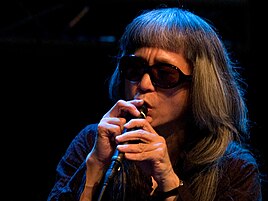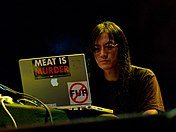| Japanoise | |
|---|---|
| Stylistic origins | Noise music |
| Cultural origins | Late 1970s, Japanese underground; height of popularity in late 1980s and 1990s |
| Derivative forms | |
| Fusion genres | |
| Other topics | |
| Post-industrial music | |
Japanoise (ジャパノイズ, Japanoizu), a portmanteau of "Japanese" and "noise", is the noise music scene of Japan. [1] [2]
Nick Cain of The Wire identifies the "primacy of Japanese Noise artists like Merzbow, Hijokaidan and Incapacitants as one of the major developments in noise music since 1990. [3]
Certain Japanese noise artists themselves feel uncomfortable being categorized under the umbrella of "Japanese noise", arguing that use of the term is a way of ignoring the differences between musicians who don't necessarily follow the same approach or even know each other at all. [4]
History
On May 8, 1960, six young Japanese musicians, including Takehisa Kosugi and Yasunao Tone, formed the Group Ongaku with two tape recordings of noise music: Automatism and Object. These recordings made use of a mixture of traditional musical instruments along with a vacuum cleaner, a radio, an oil drum, a doll, and a set of dishes. Moreover, the speed of the tape recording was manipulated, further distorting the sounds being recorded. [5] In the late 1970s and early 1980s, Merzbow took Lou Reed's album Metal Machine Music as a point of departure and further abstracted the noise aesthetic by freeing the sound from guitar based feedback alone, a development that is thought to have heralded noise music as a genre. [6]
According to Paul Hegarty (2007), "In many ways it only makes sense to talk of noise music since the advent of various types of noise produced in Japanese music, and in terms of quantity this is really to do with the 1990s onwards [...]. With the vast growth of Japanese noise, finally, noise music becomes a genre". [7] Other key Japanese noise artists that contributed to this upsurge of activity include Hijokaidan, Boredoms, C.C.C.C., Incapacitants, KK Null, Yamazaki Maso, Solmania, K2, The Gerogerigegege, Mayuko Hino, Ruins and Hanatarash. [8] [9] During the 1990s, the scene also began to gain recognition overseas, as artists such as Sonic Youth and John Zorn introduced many Japanoise performers to American audiences. [10]
See also
References
- ^ David Novak, Japanoise: Music at the Edge of Circulation, Duke University Press. 2013
- ^ Nancy Kilpatrick, The Goth Bible: A Compendium for the Darkly Inclined, New York: St. Martin's Griffin, 2004, chapter 5, "Music of the Macabre," p. 86.
- ^ Nick Cain, "Noise", The Wire Primers: A Guide to Modern Music, Rob Young, ed., London: Verso, 2009, p. 29.
- ^ Toshiji Mikawa, "日本のノイズを語る", G-Modern, 1994. http://japanoise.net/j/incapa15.htm Archived 2009-06-07 at the Wayback Machine
- ^ Mereweather, Charles (2007). Art, Anti-art, Non-art: Experimentations in the Public Sphere in Postwar Japan, 1950-1970. Getty Research Institute. pp. 13 and 16. ISBN 978-0892368662.
- ^ "Japanoise.net". japanoise.net. Retrieved 29 March 2018.
- ^ Hegarty, Paul (2007). Noise/music : a history. New York: Continuum. p. 133. ISBN 978-0-8264-1726-8. OCLC 145379732.
- ^ "japanoise.net-index". japanoise.net.
- ^ Young, Rob (2009). The Wire Primers: A Guide To Modern Music. Verso; Original Edition. ISBN 978-1844674275.
- ^ Matsumura, Masato (2014-10-14). "The Birth of Noise in Japan". Red Bull Music Academy. Retrieved 2024-01-29.


